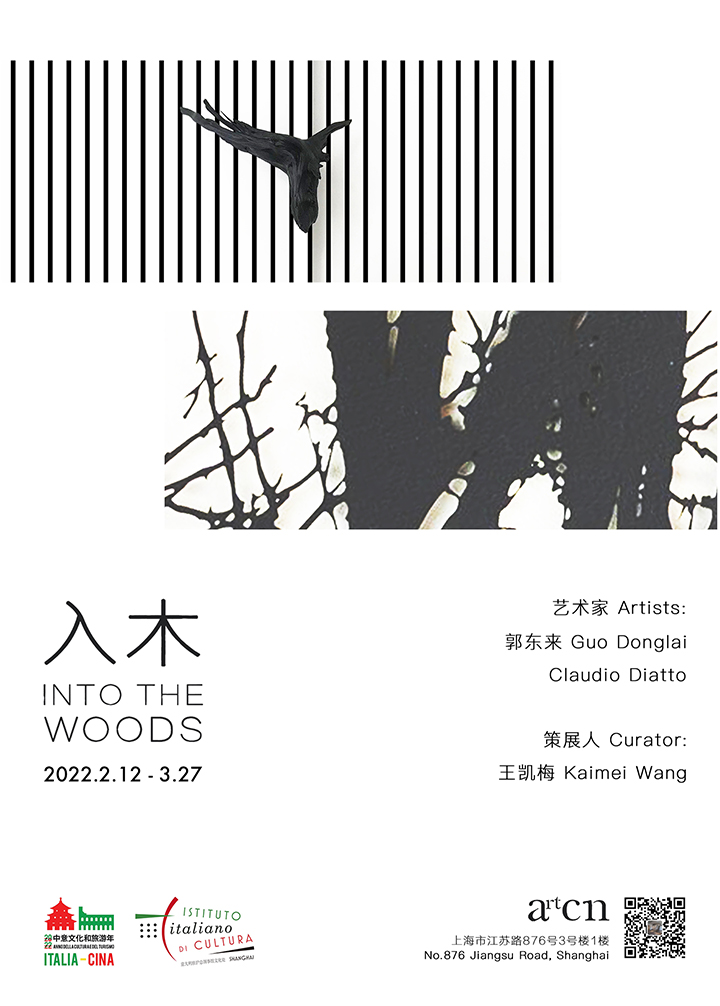
The common ground shared by the two artists at this exhibition, who come from different countries and who belong to different generations, is wood. Guo Donglai works with natural tree branches or cuts, polishes and rearranges pieces of wood in patterns and forms. On the other hand, Diatto’s colorful collage of paper is deeply rooted in his fascination for the woods which has been the constant inspiration during his long artist career. At first sight, these two artists, who have never met each other in life, convey the same kind of passion for natural material, although the reasons that lead them into the woods are uniquely different.
For Claudio Diatto, who made a decision to retreat to the woods at the age of 25 after a traumatic family loss, the forest is the place where his unsettled soul found peace. The silence of the woods healed his wounds and generated a power of creativity which in turn was projected into his wood-based artworks. For Guo Donglai, his art has always been a reflection about the state of things in their natural form and art’s initial function as mimesis of nature. From his Peking Opera family heritage and later his professional study of stage design, Guo has adapted Peking Opera’s symbolic language into his art and has employed natural material on his canvases to create the real, the illusionary, and the co-existence of both.
In this exhibition, 40 small colorful works on paper from Claudio Diatto’s series Divenire ( the Italian word for Become) were taken from a larger work called The Fertile Hand. We decided to exhibit a replicate of the original work in this exhibition just to show the pleasure of art making for Diatto. Through cutting, painting and eventually assembling, the artist has returned to his childhood woods. The bright Matisse-styled color combinations follow his own logic, between creating figurative details and illustrating abstract emotions, he takes pleasure in the euphony of creating. Guo Donglai’s artworks contains simple lines, grids, a tree branch, and several pieces of cobble stone. The constellation of these things forms various visual labyrinths, up and down, concave and convex, challenging our cognition.
What makes the meeting of the two artists more dramatic is that they both arrive via their connection with Italy. Diatto is a native of Turin where one of contemporary art history’s most important art movements, Arte Povera, originated in the 1960s. He still remembers amazing encounters with some of the movement’s founders at the tables of the cafes under the Arcades of Via Po and Piazza Castello as a teenager. He also draws inspiration from the Italian architect Renzo Piano whose architectural silence is the response to Diatto’s solitude in the woods.
When Guo Donglai finished his art study in Bologna in 2015, the heyday of Arte Povera was but a legend, however the legacy of the movement, the celebrations of everyday objects and elements of nature have become an intimate part of Guo’s artistic language as well as his approach to Chinese theater traditions and ancient philosophy. With emphasis on craftsmanship and the quality of natural material, he strives to deflate the supposed superiority of human beings empowered by technical developments since the Industrial Revolution.
In the early days of the United States, the American thinker and writer Ralph Waldo Emerson disturbed by his country’s exploitation of nature, retreated into the woods living in solitude. In his book Nature (1836), he encourages us to live in harmony with nature in order to reach the spiritual and moral sublime. Today the world is facing ever so many urgent crises, with global warming, biological extinction and the pandemic, it is indeed high time for us to go back into the woods and come to terms with Mother Nature, the way that the artists in this exhibition have shown through their artworks.